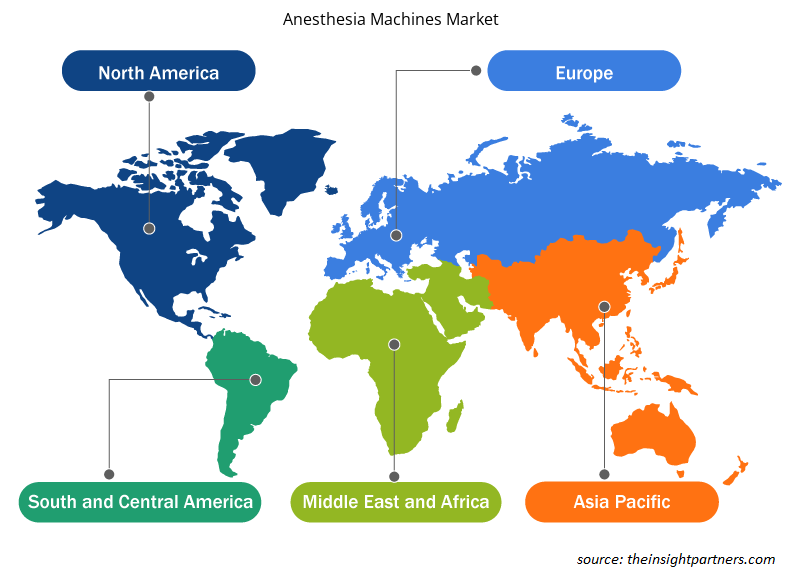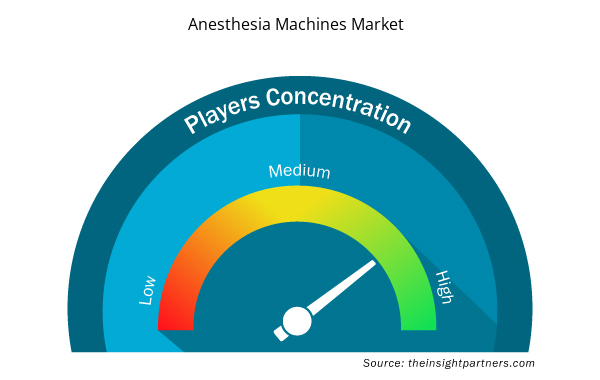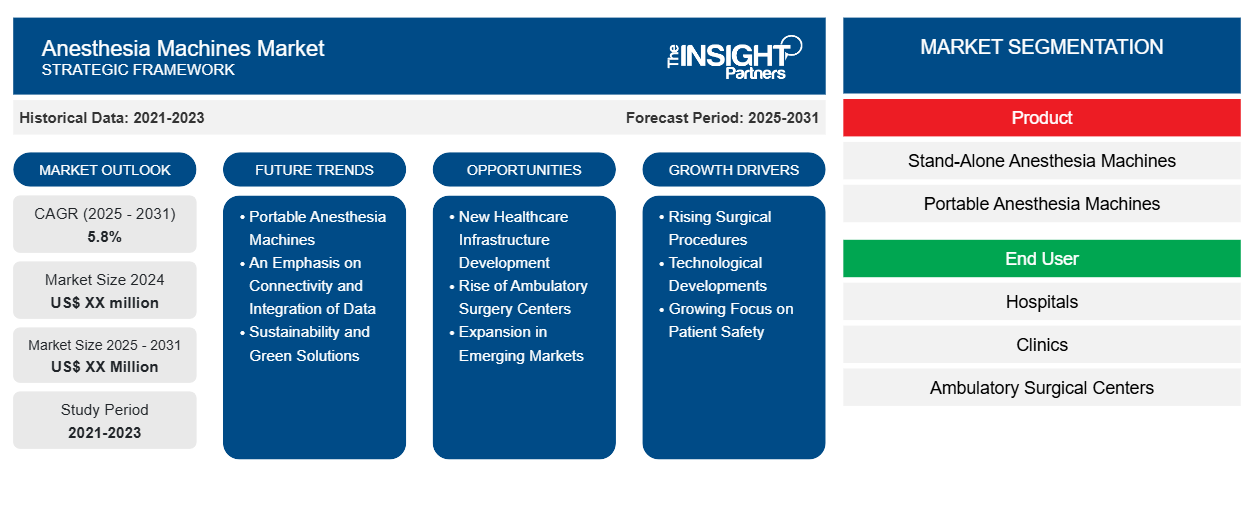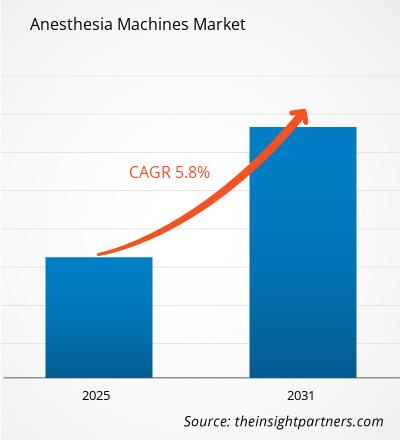Si prevede che il mercato delle macchine per anestesia registrerà un CAGR del 5,8% dal 2024 al 2031, con una dimensione di mercato in espansione da XX milioni di dollari nel 2024 a XX milioni di dollari entro il 2031.
Il report è segmentato per Prodotto (Macchine per Anestesia Autonome, Macchine per Anestesia Portatili). Inoltre, è segmentato in base all'Utente Finale (Ospedali, Cliniche, Centri Chirurgici Ambulatoriali). L'analisi globale è ulteriormente suddivisa a livello regionale e nei principali Paesi. Il report offre il valore in USD per l'analisi e i segmenti di cui sopra.
Scopo del rapporto
Il report Anesthesia Machines Market di The Insight Partners mira a descrivere il panorama attuale e la crescita futura, i principali fattori trainanti, le sfide e le opportunità. Ciò fornirà spunti a vari stakeholder aziendali, come:
- Fornitori/produttori di tecnologia: per comprendere le dinamiche di mercato in evoluzione e conoscere le potenziali opportunità di crescita, consentendo loro di prendere decisioni strategiche informate.
- Investitori: condurre un'analisi completa delle tendenze in merito al tasso di crescita del mercato, alle proiezioni finanziarie del mercato e alle opportunità esistenti lungo la catena del valore.
- Enti di regolamentazione: regolamentano le politiche e le attività di controllo sul mercato allo scopo di ridurre al minimo gli abusi, preservare la fiducia degli investitori e sostenere l'integrità e la stabilità del mercato.
Segmentazione del mercato delle macchine per anestesia
Prodotto
- Macchine per anestesia autonome
- Macchine per anestesia portatili
Utente finale
- Ospedali
- Cliniche
- Centri chirurgici ambulatoriali
Personalizza questo report in base alle tue esigenze
Riceverai la personalizzazione gratuita di qualsiasi report, comprese parti di questo report, o analisi a livello nazionale, pacchetto dati Excel, oltre a usufruire di grandi offerte e sconti per start-up e università
- Scopri le principali tendenze di mercato in questo rapporto.Questo campione GRATUITO includerà analisi di dati che spaziano dalle tendenze di mercato alle stime e alle previsioni.
Fattori trainanti della crescita del mercato delle macchine per anestesia
- Procedure chirurgiche in aumento: un altro fattore chiave del mercato delle macchine per anestesia è il numero di interventi chirurgici eseguiti in tutto il mondo. A causa di un sistema sanitario in via di sviluppo e di una popolazione in crescita, le procedure richieste diventano sempre più operative, portando così a una crescente necessità di apparecchiature per anestesia affidabili. Ciò accelera successivamente la crescita del mercato in tutti i tipi di contesti sanitari a causa della crescente domanda di apparecchiature per anestesia sicure ed efficienti.
- Sviluppi tecnologici: il mercato è fortemente influenzato dalla velocità con cui si sta verificando il progresso tecnologico nell'anestesia. I progressi tecnologici nelle macchine per anestesia intelligenti che aiutano a monitorare l'anestesia integrata aumentano i livelli di sicurezza e semplificano i processi. I miglioramenti tecnologici hanno garantito risultati migliori nei pazienti sottoposti a operazioni e gli operatori sanitari sono spinti a investire in nuove apparecchiature per anestesia.
- Attenzione crescente alla sicurezza del paziente: la crescente enfasi sulla sicurezza e il comfort del paziente è diventata la forza trainante del mercato delle macchine per anestesia. Le soluzioni avanzate per anestesia che riducono i rischi di tali trattamenti diventano il centro dell'attenzione per ospedali e centri chirurgici. Tale attenzione alla migliore assistenza al paziente promuoverà la domanda di macchine per anestesia sofisticate che incorporino tutte le più recenti funzionalità di sicurezza.
Tendenze future del mercato delle macchine per anestesia
- Macchine per anestesia portatili: più di recente, le macchine per anestesia portatili stanno guadagnando terreno attraverso una tendenza a servire la chirurgia mobile e le località remote. Questi dispositivi leggeri e piccoli assicurano un'anestesia adeguata in contesti diversi; saranno comodi per le persone per un migliore accesso alle cure chirurgiche. La loro versatilità sta catturando l'attenzione degli operatori sanitari, specialmente nelle regioni sottoservite.
- Un'enfasi sulla connettività e l'integrazione dei dati: tendenza crescente nel mercato delle macchine per anestesia La connessione alle cartelle cliniche elettroniche e ai sistemi di monitoraggio, dispositivi che possono consentire senza problemi un migliore scambio di dati e una migliore gestione dei pazienti hanno contribuito a miglioramenti generali nelle tendenze relative alla connettività e all'integrazione dei dati. L'aumento dell'enfasi sul miglioramento dell'efficienza nel flusso di lavoro e nei risultati nei pazienti li ha resi più desiderabili in termini di soluzioni integrate.
- Sostenibilità e soluzioni ecologiche: le soluzioni di sostenibilità stanno diventando sempre più influenti nel mercato delle apparecchiature per anestesia, poiché le aziende esplorano innovazioni nei materiali ecologici e nelle migliori pratiche. Lentamente, vengono adottati gli aspetti della riutilizzabilità, della riduzione degli sprechi e della minore generazione di rifiuti. Questo approccio alla responsabilità ambientale trova una buona sinergia e spinge gli operatori sanitari a soluzioni di anestesia più ecologiche all'interno di contesti clinici.
Opportunità di mercato per le macchine per anestesia
- Sviluppo di nuove infrastrutture sanitarie: l'aumento delle infrastrutture sanitarie dovrebbe essere una causa importante per la crescita del mercato delle macchine per anestesia, specialmente nei paesi in via di sviluppo. Con l'arrivo di nuovi ospedali e centri chirurgici, la domanda di moderne apparecchiature per anestesia crescerà. Ciò offrirà una discreta quantità di opportunità ai produttori di entrare in nuovi mercati per soddisfare i requisiti emergenti delle strutture sanitarie in espansione.
- Ascesa dei centri chirurgici ambulatoriali: lo sviluppo dei centri chirurgici ambulatoriali (ASC) rappresenta la più grande opportunità per le macchine per anestesia. Poiché gli interventi chirurgici eseguiti in regime ambulatoriale stanno diventando più comuni e comportano tempi di preparazione molto più brevi, cresce anche la domanda di sistemi per anestesia compatti ed efficienti. Ciò motiva i produttori a progettare macchine speciali che soddisfino esigenze rigorosamente definite negli ASC.
- Espansione nei mercati emergenti: nei mercati emergenti, l'assistenza sanitaria ha sperimentato investimenti massicci; ciò significa che c'è una successione quasi continua di opportunità per i produttori di macchine per anestesia. L'investimento in infrastrutture sanitarie migliorate in queste regioni significa che c'è una domanda crescente di soluzioni per anestesia di fascia alta. Le aziende possono cogliere tale opportunità realizzando macchine convenienti e di alta qualità che soddisfano i requisiti dell'espansione delle infrastrutture mediche.
Approfondimenti regionali sul mercato delle macchine per anestesia
Le tendenze regionali e i fattori che influenzano il mercato delle macchine per anestesia durante il periodo di previsione sono stati ampiamente spiegati dagli analisti di Insight Partners. Questa sezione discute anche i segmenti e la geografia del mercato delle macchine per anestesia in Nord America, Europa, Asia Pacifico, Medio Oriente e Africa e Sud e Centro America.

- Ottieni i dati specifici regionali per il mercato delle macchine per anestesia
Ambito del rapporto di mercato sulle macchine per anestesia
| Attributo del report | Dettagli |
|---|---|
| Dimensioni del mercato nel 2024 | XX milioni di dollari USA |
| Dimensioni del mercato entro il 2031 | XX milioni di dollari USA |
| CAGR globale (2025 - 2031) | 5,8% |
| Dati storici | 2021-2023 |
| Periodo di previsione | 2025-2031 |
| Segmenti coperti | Per Prodotto
|
| Regioni e Paesi coperti | America del Nord
|
| Leader di mercato e profili aziendali chiave |
|
Densità dei player del mercato delle macchine per anestesia: comprendere il suo impatto sulle dinamiche aziendali
Il mercato delle macchine per anestesia sta crescendo rapidamente, spinto dalla crescente domanda degli utenti finali dovuta a fattori quali l'evoluzione delle preferenze dei consumatori, i progressi tecnologici e una maggiore consapevolezza dei benefici del prodotto. Con l'aumento della domanda, le aziende stanno ampliando le loro offerte, innovando per soddisfare le esigenze dei consumatori e capitalizzando sulle tendenze emergenti, il che alimenta ulteriormente la crescita del mercato.
La densità degli operatori di mercato si riferisce alla distribuzione di aziende o società che operano in un particolare mercato o settore. Indica quanti concorrenti (operatori di mercato) sono presenti in un dato spazio di mercato in relazione alle sue dimensioni o al valore di mercato totale.
Le principali aziende che operano nel mercato delle macchine per anestesia sono:
- Farmacia medica Smith
- ELETTRICA GENERALE
- Medtronic
- Assistenza sanitaria Spacelabs
- Società Drägerwerk AG & Co. KGaA
Disclaimer : le aziende elencate sopra non sono classificate secondo un ordine particolare.

- Ottieni una panoramica dei principali attori del mercato delle macchine per anestesia
Punti di forza chiave
- Copertura completa: il rapporto copre in modo completo l'analisi di prodotti, servizi, tipologie e utenti finali del mercato delle macchine per anestesia, fornendo una panoramica olistica.
- Analisi degli esperti: il rapporto è compilato sulla base della conoscenza approfondita di esperti e analisti del settore.
- Informazioni aggiornate: il rapporto garantisce la pertinenza aziendale grazie alla copertura di informazioni recenti e tendenze nei dati.
- Opzioni di personalizzazione: questo report può essere personalizzato per soddisfare le esigenze specifiche del cliente e adattarsi in modo appropriato alle strategie aziendali.
Il rapporto di ricerca sul mercato delle macchine per anestesia può quindi aiutare a guidare il percorso di decodifica e comprensione dello scenario del settore e delle prospettive di crescita. Sebbene possano esserci alcune preoccupazioni valide, i vantaggi complessivi di questo rapporto tendono a superare gli svantaggi.
- Analisi storica (2 anni), anno base, previsione (7 anni) con CAGR
- Analisi PEST e SWOT
- Valore/volume delle dimensioni del mercato - Globale, regionale, nazionale
- Industria e panorama competitivo
- Set di dati Excel



Report Coverage
Revenue forecast, Company Analysis, Industry landscape, Growth factors, and Trends

Segment Covered
This text is related
to segments covered.

Regional Scope
North America, Europe, Asia Pacific, Middle East & Africa, South & Central America

Country Scope
This text is related
to country scope.
Domande frequenti
The rising surgical procedures and growing focus on patient safety are the major factors boosting the anesthesia machines market growth.
North America region accounts for highest revenue share in anesthesia machines market.
Asia Pacific is estimated to grow at the highest CAGR over the forecast period (2023 - 2031).
The anesthesia machines market is expected to grow at a CAGR of 5.8%.
The final report will duly include market size and projection estimates for all the segments from 2021 to 2031, along with a revenue share and compound annual growth rate (%) for the regional/country-wise market wherein 2021-2022 are the historic years, 2023 is considered to be the base year, and the forecast will be provided till 2031, along with CAGR (%).
Smiths Medical, GE Healthcare, and Medtronic are the major companies operating in the anesthesia machines market.
Trends and growth analysis reports related to Life Sciences : READ MORE..
The List of Companies
1. Smiths Medical
2. GENERAL ELECTRIC
3. Medtronic
4. Spacelabs Healthcare
5. Drägerwerk AG & Co. KGaA
6. BEIJING AEONMED CO., LTD.
7. HEYER Medical AG
8. Oricare, Inc.
9. BD
10. Supera Anesthesia Innovations
The Insight Partners performs research in 4 major stages: Data Collection & Secondary Research, Primary Research, Data Analysis and Data Triangulation & Final Review.
- Data Collection and Secondary Research:
As a market research and consulting firm operating from a decade, we have published and advised several client across the globe. First step for any study will start with an assessment of currently available data and insights from existing reports. Further, historical and current market information is collected from Investor Presentations, Annual Reports, SEC Filings, etc., and other information related to company’s performance and market positioning are gathered from Paid Databases (Factiva, Hoovers, and Reuters) and various other publications available in public domain.
Several associations trade associates, technical forums, institutes, societies and organization are accessed to gain technical as well as market related insights through their publications such as research papers, blogs and press releases related to the studies are referred to get cues about the market. Further, white papers, journals, magazines, and other news articles published in last 3 years are scrutinized and analyzed to understand the current market trends.
- Primary Research:
The primarily interview analysis comprise of data obtained from industry participants interview and answers to survey questions gathered by in-house primary team.
For primary research, interviews are conducted with industry experts/CEOs/Marketing Managers/VPs/Subject Matter Experts from both demand and supply side to get a 360-degree view of the market. The primary team conducts several interviews based on the complexity of the markets to understand the various market trends and dynamics which makes research more credible and precise.
A typical research interview fulfils the following functions:
- Provides first-hand information on the market size, market trends, growth trends, competitive landscape, and outlook
- Validates and strengthens in-house secondary research findings
- Develops the analysis team’s expertise and market understanding
Primary research involves email interactions and telephone interviews for each market, category, segment, and sub-segment across geographies. The participants who typically take part in such a process include, but are not limited to:
- Industry participants: VPs, business development managers, market intelligence managers and national sales managers
- Outside experts: Valuation experts, research analysts and key opinion leaders specializing in the electronics and semiconductor industry.
Below is the breakup of our primary respondents by company, designation, and region:

Once we receive the confirmation from primary research sources or primary respondents, we finalize the base year market estimation and forecast the data as per the macroeconomic and microeconomic factors assessed during data collection.
- Data Analysis:
Once data is validated through both secondary as well as primary respondents, we finalize the market estimations by hypothesis formulation and factor analysis at regional and country level.
- Macro-Economic Factor Analysis:
We analyse macroeconomic indicators such the gross domestic product (GDP), increase in the demand for goods and services across industries, technological advancement, regional economic growth, governmental policies, the influence of COVID-19, PEST analysis, and other aspects. This analysis aids in setting benchmarks for various nations/regions and approximating market splits. Additionally, the general trend of the aforementioned components aid in determining the market's development possibilities.
- Country Level Data:
Various factors that are especially aligned to the country are taken into account to determine the market size for a certain area and country, including the presence of vendors, such as headquarters and offices, the country's GDP, demand patterns, and industry growth. To comprehend the market dynamics for the nation, a number of growth variables, inhibitors, application areas, and current market trends are researched. The aforementioned elements aid in determining the country's overall market's growth potential.
- Company Profile:
The “Table of Contents” is formulated by listing and analyzing more than 25 - 30 companies operating in the market ecosystem across geographies. However, we profile only 10 companies as a standard practice in our syndicate reports. These 10 companies comprise leading, emerging, and regional players. Nonetheless, our analysis is not restricted to the 10 listed companies, we also analyze other companies present in the market to develop a holistic view and understand the prevailing trends. The “Company Profiles” section in the report covers key facts, business description, products & services, financial information, SWOT analysis, and key developments. The financial information presented is extracted from the annual reports and official documents of the publicly listed companies. Upon collecting the information for the sections of respective companies, we verify them via various primary sources and then compile the data in respective company profiles. The company level information helps us in deriving the base number as well as in forecasting the market size.
- Developing Base Number:
Aggregation of sales statistics (2020-2022) and macro-economic factor, and other secondary and primary research insights are utilized to arrive at base number and related market shares for 2022. The data gaps are identified in this step and relevant market data is analyzed, collected from paid primary interviews or databases. On finalizing the base year market size, forecasts are developed on the basis of macro-economic, industry and market growth factors and company level analysis.
- Data Triangulation and Final Review:
The market findings and base year market size calculations are validated from supply as well as demand side. Demand side validations are based on macro-economic factor analysis and benchmarks for respective regions and countries. In case of supply side validations, revenues of major companies are estimated (in case not available) based on industry benchmark, approximate number of employees, product portfolio, and primary interviews revenues are gathered. Further revenue from target product/service segment is assessed to avoid overshooting of market statistics. In case of heavy deviations between supply and demand side values, all thes steps are repeated to achieve synchronization.
We follow an iterative model, wherein we share our research findings with Subject Matter Experts (SME’s) and Key Opinion Leaders (KOLs) until consensus view of the market is not formulated – this model negates any drastic deviation in the opinions of experts. Only validated and universally acceptable research findings are quoted in our reports.
We have important check points that we use to validate our research findings – which we call – data triangulation, where we validate the information, we generate from secondary sources with primary interviews and then we re-validate with our internal data bases and Subject matter experts. This comprehensive model enables us to deliver high quality, reliable data in shortest possible time.


 Ottieni un campione gratuito per questo repot
Ottieni un campione gratuito per questo repot